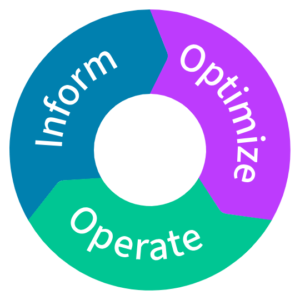Infinite Horizons: Scaling Beyond Limits with Cloud FinOps
Your Partner to Pioneering Possibilities: Cloud FinOps
Optimize Cloud Costs
Welcome to Bilytica Cloud FinOps! Our solutions are designed to tackle cloud financial and operational challenges, ensuring cost efficiency and strategic value. Discover how we optimize your cloud resources and enhance financial management.


Assessment and Planning
Expertly conducting financial assessments and developing strategic plans to align cloud spending with business objectives, ensuring cost efficiency and financial governance.

Cost Optimization
Specialized in the implementation of cost optimization strategies and tools, focusing on effective resource utilization and significant reduction in cloud expenses.

Automation and Integration
Mastery in deploying and configuring automation tools for cost tracking, reporting, and integration with IT systems to streamline cloud financial operations.
Why Cloud FinOps?
FinOps Phases

Inform
Visibility & Allocation
In the Inform phase of FinOps, teams identify data sources for cloud cost, usage, and efficiency. This data aids in budgeting, forecasting, KPI building, and revealing cloud spending value. Accurate allocation ensures precise reporting and ROI tracking. Continuous, data-driven decisions and benchmarking against others provide insights into cloud usage and operational effectiveness.
Optimize
Rates & Usage
In the Optimize phase of FinOps, teams use Inform phase data to enhance cloud efficiency. This includes rightsizing resources, adopting modern architectures, managing workloads, and automating waste elimination. Optimization also involves leveraging cloud rate discounts like RIs, SPs, and CUDs. Collaboration ensures cloud performance aligns with goals, maximizing cloud investment value.
Operate
Continuous Improvement & Usage
In the Operate phase of FinOps, organizations implement changes using data from the Inform and Optimize phases. This includes establishing governance policies, compliance monitoring, and developing training programs, guidelines, and automation policies. Success requires a culture of accountability, collaboration, and continuous improvement, looping back to refine strategies and workflows.
Organizations use tools to analyze trends and variances, tying cloud spend to business goals. Internal benchmarks encourage best practices, improving financial management, while industry benchmarks provide a broader view of progress.
A centralized team governs FinOps, ensuring efficient use of discounts and volume savings, including RIs and Saving Plans. This team handles rate negotiations, allowing others to focus on cost management and optimization. Granular cost allocation is also provided.
FinOps drives collaboration across finance, IT, and engineering teams by using cost as an efficiency metric. Organizations define governance and controls for cloud costs, enhancing efficiency and innovation across teams and the entire organization.
Teams manage their cloud usage and ensure costs fit the budget, fostering ownership and visibility into spending. Team-level objectives help maintain accountability for cloud costs, encouraging adjustments as needed for better financial management.
Efficient reporting tools provide real-time feedback, crucial for cost management and business value increase. Resource usage visibility enables fast adjustments, reducing over/under-provisioning. Automation drives continuous improvement in FinOps processes.
FinOps leverages the cloud’s cost model to prevent cost spikes, ensuring resources are right-sized. This approach guarantees teams get appropriate resources at the lowest cost, optimizing cloud usage and financial efficiency across the organization.
FineOps Personas
Implementing FinOps requires collaboration among various stakeholders, not just the FinOps team. All involved in using, tracking, managing, or directing cloud usage benefit from working together using the FinOps Framework as an operating model.
FinOps Maturity Model
- Very little reporting and tooling
- Measurements only provide insight into the benefits of maturing the capability
- Basic KPIs set for the measurement of success
- Basic processes and policies are defined around the capability
- Capability is understood but not followed by all the major teams within the organization
- Plans to address “low hanging fruit”
- Capability is understood and followed within the organization
- Difficult edge cases are identified but the decision not to address them is adopted
- Automation and/or processes cover most of the Capability requirements
- Most difficult edge cases (ones that threaten the financial well-being of the organization) are identified and effort to resolve has been estimated
- Medium to high goals/KPIs set on the measurement of success
- Capability is understood and followed by all teams within the organization
- Difficult edge cases are being addressed
- Very high goals/KPIs set on the measurement of success
- Automation is the preferred approach
FinOps Domains & Capabilities
Understand Cloud Usage & Cost
Capabilities
Quantify Business Value
Capabilities
Optimize Cloud Usage & Cost
Capabilities
Manage the FinOps Practice
Capabilities
Solutions

























